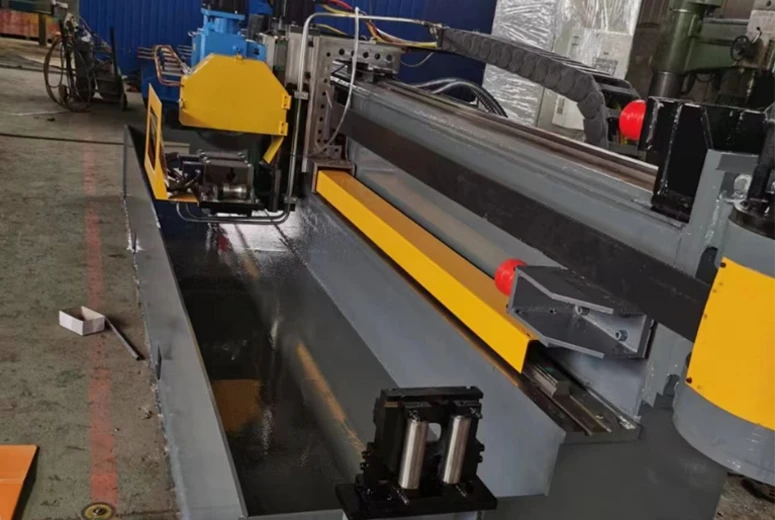roll straightener machine
Understanding the Roll Straightener Machine An Essential Tool for Metal Fabrication
In the world of metal fabrication, precision is paramount. One of the critical pieces of equipment that plays a vital role in achieving this precision is the roll straightener machine. Designed to bend and straighten metal components efficiently, this machine is integral to a wide array of industries, including automotive, construction, and aerospace.
A roll straightener machine typically comprises a series of rollers arranged in a specific configuration to process metalwork. The primary function of these machines is to eliminate bends, curves, and other imperfections from metal strips or bars, ensuring they meet the required specifications for further fabrication or assembly. By applying pressure through multiple rollers, the machine systematically smooths out inconsistencies and curvatures, producing straightened metal that is ready for subsequent processing such as cutting, drilling, or welding.
The Working Principle of Roll Straighteners
The operational principle of the roll straightener is relatively straightforward. The metal workpieces are fed through the rollers, which exert a controlled amount of force to correct the shape of the material. The rollers can be adjusted for varying thickness and types of metal, ensuring flexibility in metal processing. As the material passes through, it undergoes plastic deformation, which alters its form without compromising its integrity.
Many roll straightener machines incorporate advanced features such as automatic feeding systems, digital displays, and programmable settings. These innovations not only enhance efficiency but also ensure consistent quality in the finished product. Operators can set specific parameters based on the characteristics of the material being processed, leading to optimal results with minimal wastage.
roll straightener machine

Applications of Roll Straightener Machines
Roll straightener machines find application across various sectors, each demanding stringent standards of precision. In the automotive industry, for instance, the straightening of metal sheets is crucial for building parts that fit perfectly during assembly. Any deviation can lead to functional issues and compromises in safety.
Similarly, in the construction sector, roll straighteners are used to prepare reinforcement bars and other structural elements that must adhere to exact specifications. They help ensure that materials like rebar are straightened and of uniform strength, crucial for maintaining the structural integrity of buildings and infrastructures.
The aerospace industry also benefits significantly from the use of roll straighteners. In this high-stakes field, even the slightest imperfections can lead to serious safety concerns. Therefore, the role of roll straighteners in preparing components for aircraft construction cannot be overstated.
Conclusion
In conclusion, the roll straightener machine is indispensable in modern metal fabrication, offering precision, efficiency, and versatility. As industries continue to evolve, the demand for mechanisms that ensure high-quality metal processing will only increase. Advanced roll straightener machines are paving the way forward, incorporating automation and digital technology to further enhance production capabilities. For any business involved in metalworking, investing in a reliable roll straightener can lead to improved product quality, reduced operational costs, and ultimately, greater profitability. Whether for large-scale manufacturing or specialized metalwork, the roll straightener remains a cornerstone of efficiency in the fabrication industry.
-
High Frequency Straight Seam Welded Pipe Production Line-BzZhou Xinghua Machinery Equipment Manufacturing Co., LTD.|Precision Welding, High EfficiencyNewsJul.30,2025
-
High Frequency Straight Seam Welded Pipe Production Line|BzZhou Xinghua|Precision Welding&EfficiencyNewsJul.30,2025
-
High Frequency Straight Seam Welded Pipe Production Line - BzZhou Xinghua|Precision Engineering&EfficiencyNewsJul.30,2025
-
High-Frequency Straight Seam Welded Pipe Production Line-BzZhou Xinghua Machinery Equipment Manufacturing Co., LTD.NewsJul.30,2025
-
High-Frequency Straight Seam Welded Pipe Production Line-BzZhou Xinghua Machinery Equipment Manufacturing Co., LTD.|Precision Manufacturing, High EfficiencyNewsJul.30,2025
-
High Frequency Straight Seam Welded Pipe Production Line-BzZhou Xinghua Machinery Equipment Manufacturing Co., LTD.|Precision Steel Pipe Manufacturing&Industrial EfficiencyNewsJul.29,2025


